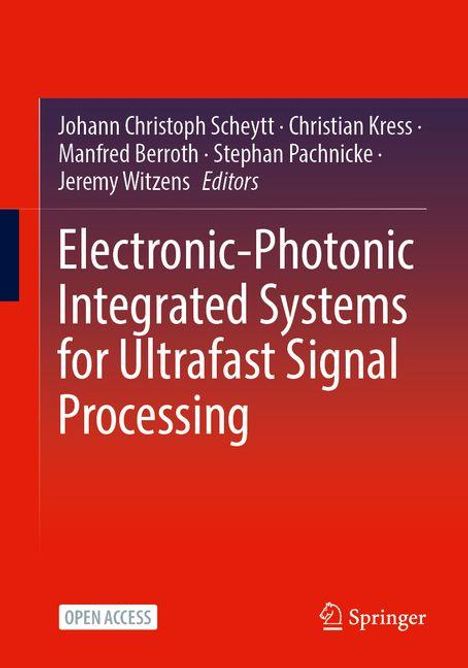Electronic-Photonic Integrated Systems for Ultrafast Signal Processing, Kartoniert / Broschiert
Electronic-Photonic Integrated Systems for Ultrafast Signal Processing
Sie können den Titel schon jetzt bestellen. Versand an Sie erfolgt gleich nach Verfügbarkeit.
- Herausgeber:
- Johann Christoph Scheytt, Christian Kress, Stephan Pachnicke, Manfred Berroth, Jeremy Witzens
- Verlag:
- Springer-Verlag GmbH, 03/2026
- Einband:
- Kartoniert / Broschiert
- Sprache:
- Englisch
- ISBN-13:
- 9783032083395
- Artikelnummer:
- 12450250
- Umfang:
- 216 Seiten
- Sonstiges:
- Approx. 250 p.
- Erscheinungstermin:
- 28.3.2026
- Hinweis
-
Achtung: Artikel ist nicht in deutscher Sprache!
Klappentext
The open access book with the title "Electronic-Photonic Integrated Systems for Ultrafast Signal Processing" is a final report of the same-titled DFG Priority Programme in the emerging field of integrated electronic-photonic systems using novel nanophotonic / nanoelectronic semiconductor technologies. The programme is funded by the Deutsche Forschungsgemeinschaft (DFG) and coordinated by Prof. Christoph Scheytt from Heinz Nixdorf Institute, Paderborn. Over the course of six years and two project phases overall 19 principal investigators and their respective research groups conducted their research in a total of 20 funded projects.
The overall objective of the Priority Programme is to address nanophotonic / nanoelectronic technology from a system perspective by investigating fundamental electronic-photonic signal processing concepts, algorithms, and novel integrated system architectures using predominantly photonic processing. By photonic-electronic integration in advanced photonic-electronic semiconductor technologies, such as silicon-on-insulator (SOI), silicon nitride (SiN), and indium phosphide (InP), the limits of electronic signal processing can be disrupted. Ultra-fast and energy-efficient information processing is required in many applications, such as communication systems, cloud computing, artificial intelligence, smart factory, instrumentation, and medical technology. Besides speed and energy efficiency, these systems have unique properties like low-cost, miniaturization, robustness, programmability.
The research and the results of the programme can be categorized in three core areas which pertain to:
- Ultra-broadband electronic-photonic signal processing with bandwidth far beyond electronic bandwidth
- Frequency synthesis as well as high-speed data converters enabled by ultralow-jitter femto-second-pulse-lasers
- Optical / THz sensing


